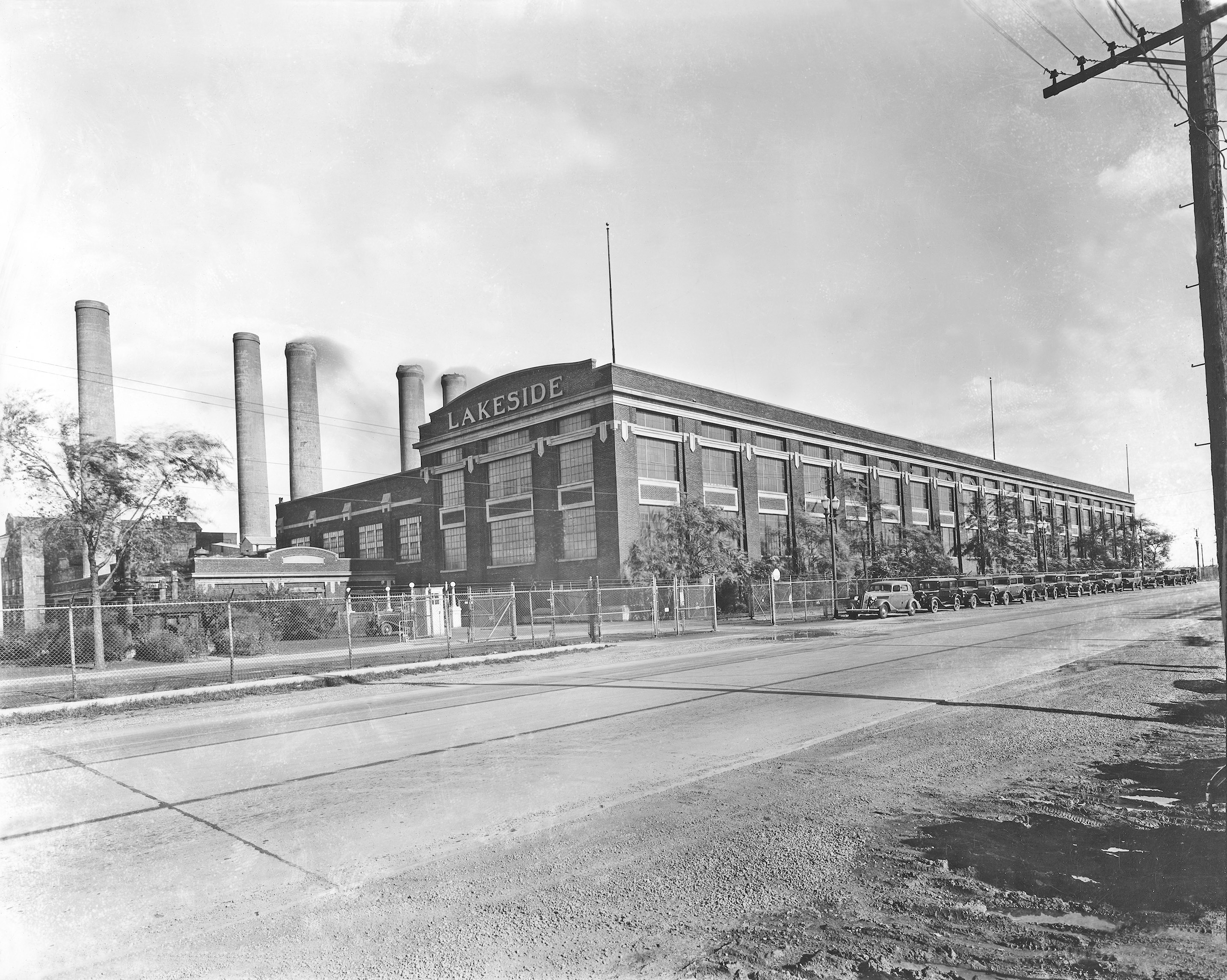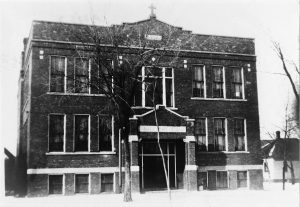At 2.55 square miles, the City of St. Francis is one of the smallest suburbs by area in Milwaukee County.[1] According to early white settlers, native residents called the area “Nojoshing,” possibly meaning “strip of land extending into the water.”[2] When the territorial government divided Milwaukee County into townships, Nojoshing became part of the Town of Lake.[3] This elevated land, rising above marshy Milwaukee, attracted American and European settlers as farmers beginning around 1834.[4]
Several Roman Catholic institutions founded in the mid-19th century gave the area a strong Catholic identity. In 1849 Archbishop John Martin Henni directed the Covenant of the Sisters of St. Francis of Assisi to settle just south of Milwaukee.[5] The sisters initially aided orphaned children, but over the next hundred years, they also founded or worked in numerous charitable organizations, including the precursor to Cardinal Stritch University.[6] In 1856, Archbishop Henni’s opened St. Francis de Sales Seminary nearby.[7] Anchored by the seminary, the area attracted a cluster of Roman Catholic institutions, including Holy Family Normal School, St. John’s School for the Deaf, Sacred Heart Church, the Chapel of the Woods, and St. Aemelian’s Orphanage.[8] In 1983, the Archdiocese of Milwaukee moved its headquarters to the Cousins Center in St. Francis.[9]
In the 1920s, residents began seeking incorporation to prevent annexation by the City of Milwaukee.[10] Those outside of St. Francis in the Town of Lake opposed the move because the Lakeside Power Plant within St. Francis, completed in 1921, provided a large amount of the town’s tax revenue.[11] Attempts to incorporate St. Francis in the 1920s, 1930s, and 1940s failed. When incorporation succeeded in 1951,[12] the city’s population was 6,181.[13] While the newly incorporated St. Francis retained the Lakeside Power Plant, later changes in state laws drastically reduced the amount of tax revenue the City received.[14] Because St. Francis lacked other large businesses to bring in revenue,[15] it had trouble providing adequate municipal services. Some St. Francis residents petitioned for merger with their southern neighbor, Cudahy.[16] After that effort failed, St. Francis eventually provided its own services.[17]
Metropolitan infrastructure was a major political concern in St. Francis. In the 1960s, residents objected to a proposed expansion of General Mitchell International Airport,[18] which abutted the southwest portion of the city. Although they blocked the expansion, residents complained about airport noise.[19] They also opposed a freeway proposed to run through the city. Its construction threatened to eliminate over one million dollars in assessed property from the tax rolls.[20] While residents’ protests initially stopped the freeway expansion project, in the 1980s they accepted an alternative plan for a 4-lane highway.[21] This parkway differed from the proposed freeway because it had a lower speed limit and decorative landscaping and lighting.[22] The Lake Parkway, which opened in 1999, connected the Hoan Bridge to the airport. The parkway spurred real estate investment in St. Francis, including upscale apartments and condominiums.[23]
The new condominium and apartments built in the wake of the Lake Parkway project diversified St. Francis’s housing makeup.[24] In 2010, there were 9,365 residents in St. Francis and of the 4,828 housing units, about half were owner occupied.[25] In that same year, about half of St. Francis’s residents lived in multi-unit structures.[26]
Footnotes [+]
- ^ “St. Francis (city), Wisconsin,” United States Census Bureau, accessed October 25, 2014.
- ^ Larry Van Goethem, And So They Came: The History of the City of St. Francis on the Occasion of Its 25th Anniversary, 1951-1976 (Franklin Press, Inc., 1976), 4.
- ^ Van Goethem, And So They Came, 4.
- ^ Van Goethem, And So They Came, 7.
- ^ Mary Eunice Hanousek, A New Assisi: The First Hundred Years of the Sisters of St. Francis of Assisi, Milwaukee, Wisconsin, 1849-1949 (Bruce Pub. Co., 1948), 15.
- ^ St. Francis Historical Society, St. Francis, Wisconsin: Celebrating 50 Years (n.p.: n.p., 2001), 12.
- ^ St. Francis Historical Society, St. Francis, Wisconsin, 12; Joseph Rainer, A Noble Priest: Joseph Salzmann, D.D., Founder of the Salesianum (Milwaukee: Olinger and Schwartz, 1903), 106; Steven M. Avella, “Catholic Life in the Archdiocese of Milwaukee: 1843-1965,” 150 Years: Archdiocese of Milwaukee, Catholic Herald, November 18, 1993, p. 18.
- ^ Steven M. Avella, In the Richness of the Earth: A History of the Archdiocese of Milwaukee, 1853-1958 (Milwaukee: Marquette University Press, 2002), 96.
- ^ John T. Witchger, “Archdiocesan Offices Move to Center,” Catholic Herald, July 28, 1983.
- ^ Van Goethem, And So They Came, 11
- ^ Van Goethem, And So They Came, 11; “Remember When…,” Milwaukee Journal, June 25, 1983, accessed October 25, 2014; “Veto Village of St. Francis,” Milwaukee Sentinel, June 21, 1932, accessed October 25, 2014.
- ^ Van Goethem, And So They Came, 11; “Fight Is Lost by St. Francis,” Milwaukee Sentinel, October 30, 1931, p. 3; “Veto Village of St. Francis,” Milwaukee Sentinel, June 21, 1932, p. 1; “Surprise Move by St. Francis! Petitions to Incorporate as City,” Milwaukee Sentinel, May 16,1951, p. 9.
- ^ M.G. Toepel and Hazel L. Kuehn, ed., “Wisconsin Cities and Villages,” in The Wisconsin Blue Book (The State of Wisconsin: Wisconsin, 1956), 606.
- ^ Avi Lank, “St. Francis Looks to Better Days,” Milwaukee Sentinel, December 9, 1975, accessed October 25, 2014.
- ^ Bill Kurtz, “Study, Experts Praise St. Francis’ Diversity of Business,” The Milwaukee Journal, December 18, 1987, accessed October 25, 2014.
- ^ “Two Resolutions Resist City Tie to St. Francis,” Milwaukee Sentinel, March 22, 1961, accessed September 23, 2014.
- ^ Van Goethem, And So They Came, 12.
- ^ “First Step Taken for Runway at Airport,” Milwaukee Journal, January 31, 1969, accessed September 30, 2014.
- ^ “First Step Taken for Runway at Airport,” Milwaukee Journal, January 31, 1969, accessed September 30, 2014; “Airport Expansion Spurs Noise Study,” Milwaukee Sentinel, April 3, 1975 accessed October 2, 2014; “Study on Noise Termed Flawed,” Milwaukee Journal, October 15, 1980, accessed October 2, 2014.
- ^ “Proposed Freeway Has St. Francis up in Arms,” Milwaukee Sentinel, January 30, 1967, accessed September 30, 2014.
- ^ Janean Marti, “Hoan Bridge Highway Spurs Concern,” Milwaukee Sentinel, April 15, 1981, accessed September 30, 2014.
- ^ Bill Kurtz, “Lake Shore Parkway Billed as an Opportunity, Showpiece,” Milwaukee Journal, November 6, 1992, accessed September 30, 2014.
- ^ Tom Daykin, “Parkway Helping Revitalize Area,” Milwaukee Journal Sentinel, July 27, 2001, accessed September 30, 2014.
- ^ Nahal Toosi, “Businesses Lukewarm on Giant Project,” The Milwaukee Journal Sentinel, March 5, 2001, accessed October 25, 2014.
- ^ “St. Francis (city), Wisconsin,” United States Census Bureau, accessed October 25, 2014.
- ^ “St. Francis (city), Wisconsin,” United States Census Bureau, accessed October 25, 2014.
For Further Reading
Hanousek, Mary Eunice. A New Assisi: The First Hundred Years of the Sisters of St. Francis of Assisi, Milwaukee, Wisconsin, 1849-1949. n.p.: Bruce Pub. Co., 1948.
St. Francis Historical Society, St. Francis, Wisconsin: Celebrating 50 Years. n.p.; n.p., 2001. https://wi-stfrancis.civicplus.com/DocumentCenter/View/38.
Van Goethem, Larry. And So They Came: The History of the City of St. Francis on the Occasion of its 25th Anniversary, 1951-1976. n.p.: Franklin Press, Inc., 1976.


So much history in St. Francis! Katie Steffan did a great job on her article!
Anna Passante
President, St. Francis Historical Society